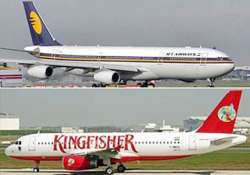DGCA Cracks Whip On Four Airlines
New Delhi, Apr 12: The DGCA cracked the whip on four airlines for violating its directive not to operate flights to Goa during certain hours when ground navigational aids at the airport are not operational

New Delhi, Apr 12: The DGCA cracked the whip on four airlines for violating its directive not to operate flights to Goa during certain hours when ground navigational aids at the airport are not operational forcing pilots to make blind landings.
The action by the aviation regulator came even as the Indian Commercial Pilot's Association(ICPA) gave a directive asking all its members not to undertake flights to Goa till April 30 in the wake of violation of flight safety rules by soem air carriers and blind landings at Dambolim airport. ICPA is a body of erstwhile Indian Airlines pilots.
The Directorate General of Civil Aviation (DGCA) had issued a NOTAM (notice to airmen) about a week ago advising all airlines not to operate flights during certain hours in a day when the ground-based radar system PAPI (precision approach path indicator) was switched off due to repairs.
"Despite our warnings to respect the curfew hours, some airlines have violated this directive. They will have to pay for it. We will take action", DGCA chief E K Bharat Bhushan told PTI today.
Official sources later said the DGCA is in the process of sending notices to Kingfisher, GoAir, JetLite and Jet Airways for having operated flights during these periods -- from 0900 hours to 1300 hours and 1500 hours till 1900 hours.
Bhushan said the NOTAM had warned all airlines not to operate flights of jet aircraft during this period due to shutting down of the crucial navigational aids.
He said he had a meeting with the chiefs of operations of all airlines "and told them that these curfew hours should be respected entirely. I had also warned them that in case of any violation, we will come down heavily on the operators as well as the flying crew".
The Indian Commercial Pilots Association (ICPA), one of the two Air India pilots' unions, has also asked its members not to operate flights to Goa during those periods when they would have to carry out "blind landings" or landings without navigational aids.
The unavailability of PAPI, which indicates the landing path, makes the pilot undertake landings visually. The radar system also indicates features like the distance and height before touchdown.
Asked about the ICPA directive to its members, Bhushan said, "I think if any association of pilots have said they are going to go by the curfew, it suits us. This is what we expect them to do".
In the directive, the ICPA has asked the pilots not to undertake flights to Goa till the Precision Approach Path Instrument (PAPI) -- runway lights and the Glide Path (GP) on both runways were not available.
"As per NOTAM issued regarding PAPI and GP not available at both runways for aircraft landing between 9am and 1pm and 3pm and 7pm from April 4 to April 30 at GOA airport. The CEC of ICPA has decided to issue the following directive, keeping air safety in concern.
"All Pilots are hereby directed 'not to undertake flights' repeat 'not to undertake flights' to VAGO (GOA) till the landing aids such as PAPI and GP are fully available and functional," ICPA General Secretary Rishabh Kapur said in a statement.
The PAPI and the GP on both runways of Goa's Dambolim airport, the only airport in the state which operates as a civil enclave in a military airbase named INS Hansa, are not available between 9 am and 1 pm and 3 pm and 7 pm to airlines due to annual maintenance work being carried out by Indian Navy.
A Notice of Airmen (NOTAM) was issued by Navy regarding closure of that these facilities would not be available from April 4 to April 30 but despite this some airlines made blind landing without navigational aid at the airport risking lives to passengers.
The PAPI is a visual aid that provides guidance information to help a pilot acquire and maintain the correct approach (in the vertical plane) to an aerodrome or an airport.
It is a light array generally located beside the runway approximately 300 meters beyond the landing threshold of the runway.
It normally consists of four equi-spaced light units colour coded to provide a visual indication of an aircraft's position relative to the designated glideslope for the runway. PTI